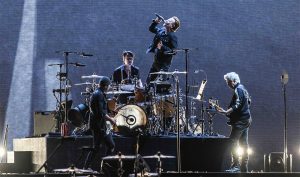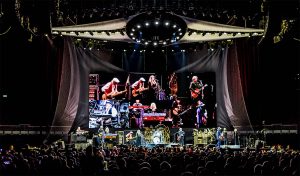Ashley Mar
They're some of the biggest drawcards on the live music scene, and boast some of the highest-grossing tours ever, but are heritage acts bringing in the cash?
It was just six months ago that Ed Sheeran found himself in the German city of Hannover, gearing up for one of the final dates of his extensive world tour. As the 28-year-old came closer to showtime, he was given the exciting news that he had surpassed U2 as having the highest-grossing tour of all time. After hundreds of shows and almost two-and-a-half years on the road, Sheeran’s ÷ Tour had eclipsed an achievement set by a band whose career overshadowed his own by decades.
Though this would be considered monumental news for any artist, the feat resonated for more than just its obvious importance; with Sheeran not only serving as the freshest face in the list of top-grossing tours, but also serving one of the few artists to achieve the feat without falling under the classification of a heritage act.
Of course, this brings into play the very method of how one defines a “heritage act”. In practice, there’s no hard and fast way of describing the concept; it’s more a case of innate recognition than anything else. Heritage acts are those artists who have always been there, have long been considered as iconic, have managed to outlive most of their contemporaries, and are sometimes found with the phrase “farewell tour” closing out the marquee these days.
To use the Rock and Roll Hall of Fame’s eligibility guidelines as an example, a heritage act could be viewed as an artist who has passed 25 years since the release of their debut album.
It’s a divisive label though. While artists such as the Rolling Stones, Elton John, and Fleetwood Mac obviously fall into this category, so do more comparatively “current” names, including Metallica and the Dave Matthews Band. Meanwhile, artists like Jennifer Lopez, the Backstreet Boys, Michael Bublé, and the Spice Girls are on the cusp of that same categorisation, with careers that are either nearing or exceed the 25-year mark.
A Global Phenomenon
In December, Billboard released their Boxscore data for the global period of November 2018 through to October 2019. While Ed Sheeran expectantly topped the list, familiar contemporaries like Pink and BTS followed closely behind. It doesn’t take much searching to find artists whose careers surpass the entire lives of the top-grossing artists though.
With Elton John, The Rolling Stones, and Metallica following in quick succession, so too does the top ten feature the likes of Paul McCartney and KISS, with the entire top 40 featuring 21 artists who either could be, or are close to being, considered a heritage act.
This trend has continued in Australia as well, with the Rolling Stones famously managing to cross the line for the the highest-grossing tour in the world back in 2014 thanks to the success of the Australian leg of their 14 On Fire trek, which brought in close to $40 million across just seven dates in the country.
Just within the last few months, Irish icons U2 brought their Joshua Tree tour to Australian shores, nine years after their U2 360° Tour (which itself is the second highest-grossing tour of all time) found its way down under. As the group soaked up the Aussie atmosphere, Pollstar named them as the highest grossing touring artist of the decade (ahead of five other heritage acts) with a gross of over $1 billion USD – and that’s before they could count the figures from their local tour.
Figures recently released by Billboard revealed that U2’s touring habits in 2019 – which featured only 15 shows between November and December – brought in a total of $73.8 million USD for the group, and saw them averaging a total of $4.63 million USD per night in Australia. Compared to the figures from last year’s Boxscore data, this would place the group among the top ten highest-grossing heritage acts.

U2 performing in Australia during their ‘The Joshua Tree’ tour. Photo by Ashley Mar.
But why are these acts so consistently successful around the world? Like the definition of the phrase “heritage act”, there’s no easy answer. However, veterans of the industry – such as Frontier Touring and Chugg Entertainment founder, Michael Chugg – contend that much of it can simply be defined by their reputation as consistent, dependable artists.
“[Heritage acts] are doing very, very well at the moment and it’s been happening for a while,” Chugg explains. “There’s a certain line that a lot of acts cross – certainly the older ones – and it doesn’t matter if they’ve had hits or not; some of the best shows in the world are from these acts and people want to go and see them.
“We tour a lot of heritage acts; Doobie Brothers, [John] Fogerty, Jimmy Buffett, and people like that, and they all do pretty well, but obviously then you’ve got the megastars that are just incredible.”
“So a lot of those acts to need to come [to Australia], and they shouldn’t come back [again] for three, four, five years.”
Of course, while these acts might consistently bring in huge numbers, it’s important for promoters to keep the law of diminishing returns in mind, with Chugg indicating the old adage of “absence makes the heart grow fonder” are words for these artists to live by.
“One of the secrets of most of these acts is that they don’t tour all the time and so people are keen to see them,” he explains. “Like, the first time Dolly Parton came back in 25 years, we did the tour and it was very, very successful. And they tried to come back 18 months later, and it was a disaster.
“So a lot of those acts need to come [to Australia], and they shouldn’t come back [again] for three, four, five years.”
Shifting Demographics
For years, the Australian market has long been considered fertile ground for touring artists. Just last year, Bluesfest’s Peter Noble pointed out that – according to Live Performance Australia – the contemporary live music industry is bigger than sport. In a report from Music Australia in 2014, the local music sector was said to be bringing in between $4 to $6 billion for the local economy, while a study from Roy Morgan Research contended that more Aussies attend live musical events than sporting events.
With this in mind, it would logically follow that with live music proving to be a huge drawcard, these heritage acts would be the ones helping to lead the musical economy. However, as Roger Field, CEO of Live Nation (whose current touring roster boasts names such as the Pixies, Rod Stewart, Pennywise, Scorpions, Whitesnake, and more) explains, any notion of these older acts dominating the musical economy might be misguided, with newer artists actually bringing in larger audiences.
“I wouldn’t go so far as to say [they’re] dominating, because the reality here and probably in the US is that pop and urban acts such as Post Malone and Kendrick Lamar are doing great numbers,” Field explains.

Fleetwood Mac performing in Australia in 2019. Photo by Ashley Mar.
“That said, there’s definitely a trend where these acts are very reliable drawcards, with a premium level ticket price. The top acts in their field such as Fleetwood Mac, are actually growing their audience with younger fans joining the audience base, beyond the significant baby boomer fans that grew up with the music.”
“Many of these acts are engaging a new audience. In the competitive environment of streaming and shorter attention spans, the drawcard of seeing live performances that defined generations and musical genres is a definite plus for the live entertainment economy.”
This sentiment is also shared by Chugg, who notes that the musical playing field is in fact dominated by younger artists.
“There’s really not that many heritage acts,” Chugg explains. “There’s a lot more young acts than there are heritage acts, and I think when you balance the incomes I would be surprised if the older acts were pulling more money.”
What About Ticket Prices?
The Wall Street Journal recently pointed out that while the Rolling Stones managed to have the highest-grossing North American tour for 2019, much of this was pushed forward by rising ticket prices. At an average of $226.61 USD per ticket, the group only needed to sell 784,607 tickets in order to achieve this feat. This is seen through data as well, with the average ticket price for the 100 highest-grossing tours increasing 55% to $94.83 across the last decade.
Meanwhile, the likes of Ariana Grande and The Jonas Brothers take up the fifth and sixth positions on this list of biggest US tours, having sold a similar number of tickets to their tours across the US in 2019. While Grande sold 700,053 tickets at an average of $117.16 USD, The Jonas Brothers charged $106.14 USD to sell a total of 769,310 tickets.
Could this then mean that these heritage acts are not in fact bringing in as many people as they usually would, but are in fact making up for it through higher ticket prices? Maybe, but it is of course worth noting that these figures saw the Rolling Stones only play 16 US shows in 2019, while Ariana Grande and The Jonas Brothers played 51 and 54, respectively.

Red Hot Chili Peppers performing in Australia in 2019. Photo by Ashley Mar.
According to an investigation from Bloomberg in 2019, much of the reason for increased ticket prices came as a response to piracy. With many fans pirating music, ticket prices had to be raised in order to offset the loss. Though, another reason came about when companies such as Ticketmaster realised many fans would pay any amount to see their favourite artists live.
While fans have increased their spending on concert tickets, so too have they forked out more for merchandise and items at the concession stand. Research offered to Bloomberg by Live Nation shows fans spent an average of $20 USD events in 2016, with that figure increasing by about 50% to $29 USD in 2019.
“The Doobie Brothers and John Fogerty, and people like that, their prices are not super high, and it depends who the act is really,” noted Michael Chugg. “When you look at some of the bigger acts, the average ticket price is around $150, $175, and obviously the VIP ticketing is quite up there. I suppose it’s demand and supply, isn’t it?
“You have to take into consideration that you have to price tours right. You get the prices of the acts wrong, and you get them too high or so forth, you can really do yourself and the acts damage, because there’s only so much money out there now, and a lot of people are choosing who they go and see.”
However, while ticket prices have risen and fans have chosen to spend more money at the venue, the biggest reason for heritage acts dominating lists of highest-grossing tours isn’t necessarily a financial one, but rather a sentimental one.
Though artists like Fleetwood Mac, Metallica, and Paul McCartney are on the road for the sake of touring as usual, farewells and retrospective shows have also increased in frequency recently. With Elton John currently wrapping up decades of touring, U2’s series of shows which saw them perform The Joshua Tree undoubtedly brought in fans of their commercial breakthrough.
“Nostalgia ties into all music,” adds Roger Field. “It’s where you were, who you were with and what was happening to you in your life. That’s the beauty of what we do every day.”

George Thorogood performing in Australia in 2020. Photo by Ashley Mar.
As Chugg also adds, much of the reason that these heritage acts have managed to pull in such huge audience numbers simply comes from decades of building an enduring legacy, and the fear that their latest tour could be their last.
“I think a lot of people look at them and go, ‘well, this might be their last tour’,” he explains. “They might go and see them because of that.
“The current Elton John show that’s on tour at the moment is one of the greatest rock shows I’ve ever seen, and I know from the 700,000 odd people that are going, they all feel the same, and the reviews are all five star. As I said earlier, there’s a line where certain acts get to a point where it doesn’t matter about their record.
“I think a lot of people look at them and go, ‘well, this might be their last tour.’ They might go and see them because of that.”
“I mean, I wouldn’t call Robbie Williams a heritage act quite yet, but he pulls huge audiences because they know it’s going to be an unbelievable show. And when you go and see some of these older acts, and you see them singing and playing, and they’re better than they were 20 years ago.
“I just love the fact that there’s no division between the demographics that go to see young acts and old acts these days. It’s all about music to me, and that’s what I see when I see an audience.”
Looking Ahead
Looking at the figures, there’s no denying that the global music scene is a healthy one, and thanks to Australian music fans and their constant appetite for live entertainment, it’s a trend that continues here as well.
Though performances from heritage acts have been seen as some of the biggest on the national touring calendar, it appears as though these artists’ abilities to break records by having the highest-grossing tours are at risk of being matched by the likes of younger artists such as Ed Sheeran, and their ability to draw in consistently massive crowds.
But what does the future hold? Will this trend continue into the foreseeable future, or will a number of retiring heritage acts manage to gain an unfair advantage by flooding the live scene with farewell tours?
Could we one day see Ed Sheeran’s inevitable last stand break records the likes of which we’ve never seen? Or will another young artist set new records within just a few years?

Iggy Pop performing in Australia in 2019. Photo by Ashley Mar.
Whatever the case, it seems that touring companies won’t look to favour any particular artist either, with the likes of Roger Field noting that they solely aim to provide fans with the chance to see the best shows on offer.
“Our objective is to promote all genres of music, and at all levels from developing acts through to established,” Field says. “Aside from the fact that we’re fans of the amazing music produced, how does one define heritage?”
“Let’s face it – whilst streaming may have destroyed the ‘album’, it’s created an incredible channel for discovery. Anyone could be listening to a piece of music from the ’50s, ’70s or ’90s and have no idea that it wasn’t written yesterday. It’s the best thing for live music!”







































